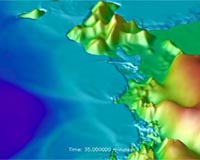| . |  |
. |
Wellington (AFP) Feb 28, 2010 Waves up to 1.5 metres (five feet) high rammed into New Zealand Sunday as a tsunami generated by a huge earthquake in Chile intensified, but there were no reports of serious damage. New Zealand's entire east coast was at risk with walls of water up to three metres (10 feet) expected to hit the Chatham Islands and Banks Peninsula, near the main South Island city of Christchurch, officials said. In the South Pacific island nation of Tonga, residents made their way to higher points inland, with memories still fresh of a tsunami in September that also hit Samoa and American Samoa, leaving more than 180 people dead. The first wave of 20 centimetres arrived at the Chathams soon after 7:00 am (1800 GMT Saturday) and within three hours the waves had risen to 1.5 metres, Rana Solomon of the Chatham Islands Council said. "It is expected that the greatest wave heights will occur between six and 12 hours after the initial arrivals," the Ministry of Civil Defence and Emergency Management said in a statement. However, officials were hopeful the tsunami would not cause severe damage when they hit mainland New Zealand throughout the day. "We can say it's unlikely to be very destructive," Ken Gledhill from the Institute of Geological and Nuclear Science (GNS) told Television New Zealand. Residents on the Chatham Islands had been moved to higher ground several hours before the first wave struck and families in low-lying areas of Banks Peninsula and near Gisborne in the North Island were told to evacuate. One Chathams resident, identified only as "Chris" told the New Zealand Press Association everyone had a perfect view of the ocean movement. "The water is starting to disappear from round the bay, all the rocks are uncovered, the water is definitely moving out. Now the rocks are covered up again. There's no big wall of water yet. It looks very unusual, very unusual. "It's kind of high tide here at the moment but sort of in no time the rocks became uncovered but they're covered up again." The Pacific Tsunami Warning Center has warned of possible "widespread damage" from waves generated by Chile's killer quake. In Tonga and the Cook Islands, also in the South Pacific, coastal residents moved to higher ground. Many islanders are still living in makeshift shelters following a devastating tsunami triggered by an 8.0 quake in September. But in New Zealand, largely unscathed from the Samoa tsunamis, many people were in no hurry to take precautions with emergency services reporting sightseers heading for areas in the process of being evacuated. In Napier, on the eastern North Island, the Sunday market went ahead on the foreshore, while elsewhere fishermen headed out to sea in small boats or took up positions on rocky outcrops unconcerned by the tsunami warnings. "I've got my flippers," one woman told the New Zealand Press Association. However, a mass nude photo shoot planned for Wellington's Breaker Bay beach was cancelled as a result of the tsunami warning.
Share This Article With Planet Earth
Related Links Bringing Order To A World Of Disasters When the Earth Quakes A world of storm and tempest
 Tsunami-generating quake possible off Indonesia: scientists
Tsunami-generating quake possible off Indonesia: scientistsParis (AFP) Jan 17, 2010 A huge wave-generating quake capable of killing as many people as in the 2004 Indian Ocean tsunami could strike off the Indonesian island of Sumatra, and the city of Padang is in the firing line, a team of seismologists said on Sunday. The group -- led by a prominent scientist who predicted a 2005 Sumatran quake with uncanny accuracy -- issued the warning in a letter to the journal Nature Ge ... read more |
|
| The content herein, unless otherwise known to be public domain, are Copyright 1995-2010 - SpaceDaily. AFP and UPI Wire Stories are copyright Agence France-Presse and United Press International. ESA Portal Reports are copyright European Space Agency. All NASA sourced material is public domain. Additional copyrights may apply in whole or part to other bona fide parties. Advertising does not imply endorsement,agreement or approval of any opinions, statements or information provided by SpaceDaily on any Web page published or hosted by SpaceDaily. Privacy Statement |